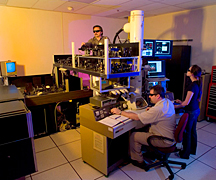- Number 315 |
- July 6, 2010
New energy research under the microscope

Curtis Brown, Thomas LaGrange and
Judy Kim make adjustments to the
dynamic transmission electron
microscope.
Scientists can now peer into the inner workings of catalyst nanoparticles 3,000 times smaller than a human hair within nanoseconds.
The findings point the way toward future work that could greatly improve catalyst efficiency in a variety of processes that are crucial to the world’s energy security, such as petroleum catalysis and catalyst-based nanomaterial growth for next-generation rechargeable batteries.
Using a new imaging technique on the Dynamic Transmission Electron Microscope (DTEM), at DOE's Lawrence Livermore’s National Laboratory, researchers have achieved unprecedented spatial and temporal resolution in single-shot images of nanoparticulate catalysts.
The DTEM uses a laser-driven photocathode to produce short pulses of electrons capable of recording electron micrographs with 15-nanosecond (one billionth of a second) exposure time. The recent addition of an annular dark field (ADF) aperture to the instrument has greatly improved the ability to time-resolve images of nanoparticles as small as 30 nanometers in diameter.
“Nanoparticles in this size range are of crucial importance to a wide variety of catalytic processes of keen interest to energy and nanotechnology researchers,” said UC Davis’ Dan Masiel, formerly of LLNL and lead author of a paper appearing in the journal, ChemPhysChem. “Time-resolved imaging of such materials will allow for unprecedented insight into the dynamics of their behavior.”
Previously, particles smaller than 50 nanometers could not be resolved in the 15-nanosecond exposure because of the limited signal and low contrast without ADF aperature. But by using DTEM’s ADF, almost every 50-nanometer particle and many 30-nanometer ones became clearly visible because of the fast time resolution and improved contrast.[Anne Stark, 925.422.9799,
stark8@llnl.gov]
